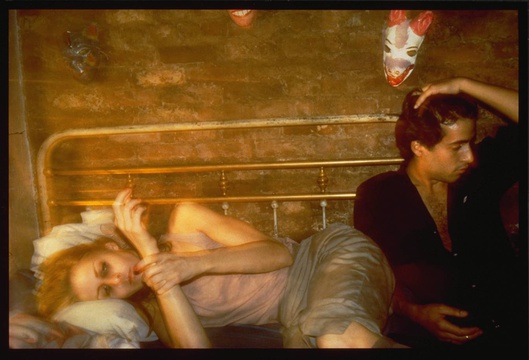
Instagram: How phony are your memories?
Published on
Signals of the past, whether it be a photograph, a piece of music or a smell, are privy to distortion as well as fantasy. Now in the age of obsessive documentation of our lives online and as we alter reality by means of posing, cropping, untagging, deleting, “beauty facing” and applying filters to our photographs, do we run the risk of producing phony memories?
The simulated world created by the latest digital technologies sounds dystopian but lest we forget - it also provides an opportunity to be who we want to be. This is a photograph I took after leafing through the mandatory Nan Goldin coffee table book required in every Kreuzberg flat. I’m hankering after the intimate “urban bohemia” of a Goldin-esque aesthetic. I’ll post it to Facebook, Instagram, Pinterest accompanied by #bohemianlifestyle #heroin chic #intellectual. If the photo looks genuine, it’s thanks to Instagram which has disguised the fact that the whole scene was staged. That I made my flatmate take the picture, that I don’t actually smoke, that I strategically arranged the book about art and activism (which I’ve never read) on the sofa, that actually I’m wide awake. At least I look cool.
 Instagram is an important perpetrator in the production of phony memories. Through a host of skeumorphic filters, blurred edges and simulated film grain, smartphone snaps can be transformed into what look like age worn and paper printed photos. The instagrammed snapshot is often highly self-aware and “photo ops” are desperately sought out as the present is increasingly seen as an opportunity to document the past. But despite its contrived nature, the instagrammed snap does its best to give the impression of authentic spontaneity, successfully disguising fabricated narratives as real moments. The results are photographs that look as if they have been discovered in a photo album from the 70's - they emit an immediate nostalgia and in turn authenticate our mindless snaps as genuine “memories”.
Instagram is an important perpetrator in the production of phony memories. Through a host of skeumorphic filters, blurred edges and simulated film grain, smartphone snaps can be transformed into what look like age worn and paper printed photos. The instagrammed snapshot is often highly self-aware and “photo ops” are desperately sought out as the present is increasingly seen as an opportunity to document the past. But despite its contrived nature, the instagrammed snap does its best to give the impression of authentic spontaneity, successfully disguising fabricated narratives as real moments. The results are photographs that look as if they have been discovered in a photo album from the 70's - they emit an immediate nostalgia and in turn authenticate our mindless snaps as genuine “memories”.
Everything can be beautiful - on Instagram
Through an Instagram filter, everything looks better. Anything as mundane as a take-away coffee cup has the ability to emit nostalgia. Through Instagram, an awkward evening with an acquaintance can be transformed in to #NightofMyLife. Not only is it weird that we unashamedly present untruths to online communities, but also dangerous if in the future, these rose-tinted photographs plus the distortion of time results in fake memories. Will we one day reflect on the photograph and think: “Why didn’t we keep in touch when we were always such good friends?”
Elizabeth Loftus on the fiction of memory (TED Talk).
Psychologist and memory expert Elizabeth Loftus claims that everyone is susceptible to memory distortion. When fed misinformation, we begin to remember things that didn’t happen. Loftus has carried out several experiments which concluded that false memories can relatively easily be imbedded into people’s minds – whether that be a false childhood memory of getting lost in a shopping mall or remembering a piece of evidence that never existed. This ease suggests that our own documentation of constructed narratives plus our willingness to believe our own fantasies has the capacity to construct false memories too.
Simulating the real and the raw
 Perhaps another reason for the trend of pre-digital photography is a subconscious yearning for something tangible within a world so simulated. Today we recreate the snapshot aesthetic made popular in the 80’s and 90’s by the likes of Nan Goldin and Corinne Day. Their honest and often unflattering photographs act as portals into their lives, revealing intense emotions and an insider’s perspective on a counter culture of drug addicts, transvestites and AIDS victims. The photos have been attributed with being ‘real’ and ‘raw’ – the exact qualities we want to see in our own photographs. Now, the average Instagram user may not frequent free parties, shoot heroin, share baths or even have an eye for a good photo, but that doesn’t matter - with Instagram’s 80’s filter, we can appropriate other people’s memories as our own and achieve the desired “look”. For now my phony appropriation of a Goldin photograph is quite embarrassing but perhaps in the future I’ll forget I wrote this article and believe my own lie.
Perhaps another reason for the trend of pre-digital photography is a subconscious yearning for something tangible within a world so simulated. Today we recreate the snapshot aesthetic made popular in the 80’s and 90’s by the likes of Nan Goldin and Corinne Day. Their honest and often unflattering photographs act as portals into their lives, revealing intense emotions and an insider’s perspective on a counter culture of drug addicts, transvestites and AIDS victims. The photos have been attributed with being ‘real’ and ‘raw’ – the exact qualities we want to see in our own photographs. Now, the average Instagram user may not frequent free parties, shoot heroin, share baths or even have an eye for a good photo, but that doesn’t matter - with Instagram’s 80’s filter, we can appropriate other people’s memories as our own and achieve the desired “look”. For now my phony appropriation of a Goldin photograph is quite embarrassing but perhaps in the future I’ll forget I wrote this article and believe my own lie.



